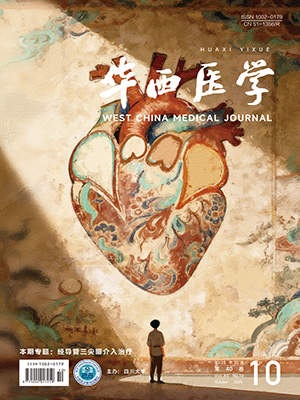| 1. |
赵红丽, 张晓凤, 农婷. 基于 citeSpace 的中医药治疗高血压肾病知识图谱可视化分析. 中国中西医结合肾病杂志, 2023, 24(10): 889-892, 944.
|
| 2. |
GBD Chronic Kidney Disease Collaboration. Global, regional, and national burden of chronic kidney disease, 1990-2017: a systematic analysis for the Global Burden of Disease Study 2017. Lancet, 2020, 395(10225): 709-733.
|
| 3. |
He L, Xue B, Wang B, et al. Impact of high, low, and non-optimum temperatures on chronic kidney disease in a changing climate, 1990-2019: a global analysis. Environ Res, 2022, 212(Pt A): 113172.
|
| 4. |
柯昌荣, 赵树勇, 玄美燕, 等. 中国 1990—2019 年慢性肾病疾病负担及变化趋势分析. 中国预防医学杂志, 2021, 22(10): 757-761.
|
| 5. |
Yang K, Yang X, Jin C, et al. Global burden of type 1 diabetes in adults aged 65 years and older, 1990-2019: population based study. BMJ, 2024, 385: e078432.
|
| 6. |
GBD 2021 Causes of Death Collaborators. Global burden of 288 causes of death and life expectancy decomposition in 204 countries and territories and 811 subnational locations, 1990-2021: a systematic analysis for the Global Burden of Disease Study 2021. Lancet, 2024, 403(10440): 2100-2132.
|
| 7. |
Clark SN, Anenberg SC, Brauer M. Global burden of disease from environmental factors. Annu Rev Public Health, 2025, 46(1): 233-251.
|
| 8. |
庄培霞. 风险分级模式的护理干预用于高血压肾病血透患者中对并发症及预后的干预研究. 心血管病防治知识, 2023, 13(26): 36-38.
|
| 9. |
王琳琳, 冯佳莉, 刘圣君, 等. 螺内酯联合沙库巴曲缬沙坦治疗高血压肾病患者的临床研究. 中国临床药理学杂志, 2024, 40(8): 1091-1095.
|
| 10. |
Pan X, Lin X, Huang X, et al. The burden of diabetes-related chronic kidney disease in China from 1990 to 2019. Front Endocrinol (Lausanne), 2022, 13: 892860.
|
| 11. |
Gui C, Shan X, Liu C, et al. Disease burden of chronic kidney disease attributable to lead exposure: a global analysis of 30 years since 1990. Chemosphere, 2023, 341: 140029.
|
| 12. |
张兴元. 高收缩压相关的全球疾病负担研究. 武汉: 武汉大学, 2022.
|
| 13. |
林玲, 黄捷, 房星星, 等. 1990—2019 年江苏省慢性肾病流行与疾病负担变化趋势. 中国预防医学杂志, 2023, 24(12): 1339-1344.
|
| 14. |
Dávila-Cervantes CA, Agudelo-Botero M. Young-onset chronic kidney disease in Mexico: secondary analysis of global burden of disease study, 1990-2019. Prev Med, 2024, 181: 107901.
|
| 15. |
Song J, Pan T, Xu Z, et al. A systematic analysis of chronic kidney disease burden attributable to lead exposure based on the global burden of disease study 2019. Sci Total Environ, 2024, 908: 168189.
|
| 16. |
Yang T, Richards EM, Pepine CJ, et al. The gut microbiota and the brain-gut-kidney axis in hypertension and chronic kidney disease. Nat Rev Nephrol, 2018, 14(7): 442-456.
|
| 17. |
Kalaitzidis RG, Elisaf MS. Treatment of hypertension in chronic kidney disease. Curr Hypertens Rep, 2018, 20(8): 64.
|
| 18. |
Hamrahian SM. Management of hypertension in patients with chronic kidney disease. Curr Hypertens Rep, 2017, 19(5): 43.
|
| 19. |
Burnier M, Damianaki A. Hypertension as cardiovascular risk factor in chronic kidney disease. Circ Res, 2023, 132(8): 1050-1063.
|
| 20. |
Zhao WM, Li XL, Shi R, et al. Global, regional and national burden of CKD in children and adolescents from 1990 to 2019. Nephrol Dial Transplant, 2024, 39(8): 1268-1278.
|
| 21. |
陈旭鹏, 尉力文, 严子康, 等. 1990—2019 年江苏省 2 型糖尿病所致慢性肾病疾病负担及变化趋势分析. 实用预防医学, 2023, 30(1): 26-30.
|
| 22. |
周智华, 宓金融, 黎倩欣, 等. 基于大数据的广州市慢性肾病疾病负担及变化趋势分析. 中国公共卫生管理, 2023, 39(4): 474-477.
|
| 23. |
Zhakhina G, Mussina K, Yerdessov S, et al. Analysis of chronic kidney disease epidemiology in Kazakhstan using nationwide data for 2014-2020 and forecasting future trends of prevalence and mortality for 2030. Ren Fail, 2024, 46(1): 2326312.
|
| 24. |
Li Y, Ning Y, Shen B, et al. Temporal trends in prevalence and mortality for chronic kidney disease in China from 1990 to 2019: an analysis of the Global Burden of Disease Study 2019. Clin Kidney J, 2022, 16(2): 312-321.
|
| 25. |
Bu Y, Liu Y, Zhou M, et al. The burden of hypertension-related chronic kidney disease - China, 2010-2019. China CDC Wkly, 2024, 6(14): 282-288.
|
| 26. |
GBD 2021 Diseases and Injuries Collaborators. Global incidence, prevalence, years lived with disability (YLDs), disability-adjusted life-years (DALYs), and healthy life expectancy (HALE) for 371 diseases and injuries in 204 countries and territories and 811 subnational locations, 1990-2021: a systematic analysis for the Global Burden of Disease Study 2021. Lancet, 2024, 403(10440): 2133-2161.
|




